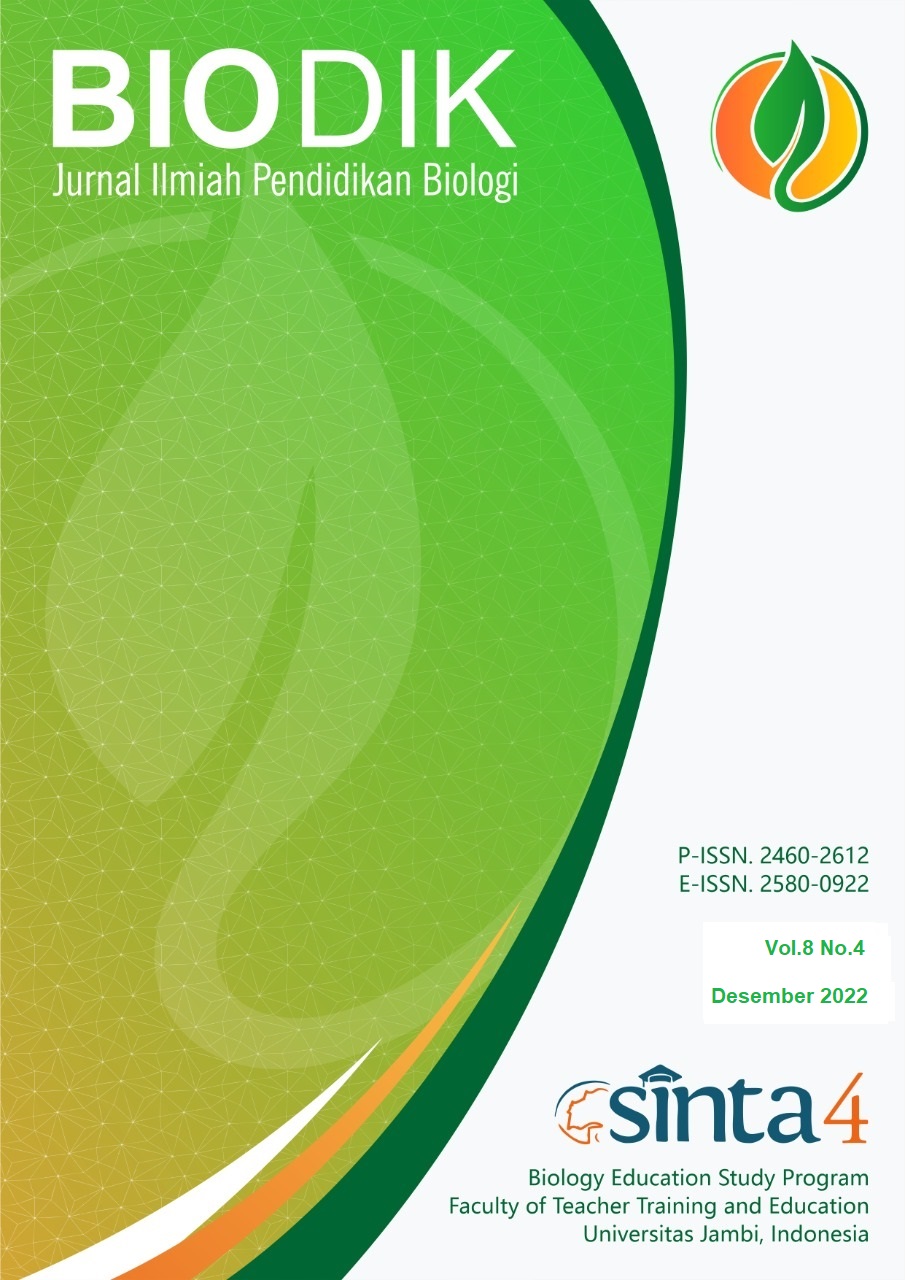Implementasi Model Inquiry dengan Berbagai Aplikasi Teknologi pada Materi Interaksi Makhluk Hidup dengan Lingkungannya
(Implementation Of The Inquiry Model With Various Applications Of Technology On Materials Interaction Of Living Things With Their Environment)
DOI:
https://doi.org/10.22437/bio.v8i4.19098Abstract
The existence of a learning paradigm and the application of a new curriculum at this time is very necessary for the application of innovative learning models. Teachers must need to apply effective and innovative learning models that are in accordance with the learning objectives to be achieved. In addition, the rapid development of science and technology has an impact on the selection of the right learning model and its use can even be combined in order to increase students' knowledge and be able to compete in responding to the development of science. One of them is the Guided Inquiry model which is suitable for use when students are known to have more difficulty conducting an investigation of a material. Writing this article aims to describe the application of the inquiry learning model with various technological applications. The results of the study found that applications that can be used to facilitate the implementation of the inquiry learning model stages and make it easier for students to learn include: Youtube, Google Docs, Zoom Applications, Canva Applications, and Instagram.
Key words: Model, Inquiry, technology app
Â
ABSTRAK
Adanya paradigma pembelajaran dan penerapan kurikulum baru saat ini maka sangat dibutuhkan adanya penerapan inovasi model pembelajaran. Guru harus perlu menerapkan model pembelajaran yang efektif dan inovatif yaitu sesuai dengan tujuan pembelajaran yang akan dicapai. Selain itu dengan pesatnya perkembangan ilmu pengetahuan dan teknologi membawa dampak terhadap pemilihan model pembelajaran yang tepat dan bahkan dapat dipadukan penggunaanya agar dapat meningkatkan pengetahuan peserta didik serta dapat bersaing dalam menanggapi perkembangan sains tersebut. Salah satunya yaitu model Guided inquiry cocok digunakan bilamana siswa-siswa diketahui mengalami kesulitan lebih dalam melakukan penyelidikan mengenai suatu materi. Penulisan artikel ini bertujuan untuk mendeskripsikan penerapan model pembelajaran inquiry dengan berbagai aplikasi teknologi. Hasil kajian ditemukan bahwa aplikasi yang dapat digunakan untuk mempermudah pelaksanaan tahapan model pembelajaran inquiry dan mempermudah siswa belajar antara lain: Youtube, Google Docs, Aplikasi Zoom, Aplikasi Canva, dan Instagram.
Kata kunci: Model, Inkuiri, aplikasi teknologi Berpikir Tingkat Tinggi, Conceptual Change Model
Downloads
References
Amprasto, A., Rustaman, N. Y., Surtikanti, H. K., & Saefudin, S. (2012). Pengembangan Model Asesmen Pada Kegiatan Field Trip Mata Kuliah Ekologi Umum Berbasis Inkuiri Untuk Meningkatkan Kemampuan Mahasiswa Calon Guru Biologi. Jurnal Pengajaran MIPA, 17(2), 200-208.
Ernst, D. C., Hodge, A., & Yoshinobu, S. (2017). What is inquiry-based learning. Notices of the AMS, 64(6), 570-574.
Friesen, S., & Scott, D. (2013). Inquiry-based learning: A review of the research literature. Alberta Ministry of Education, 32.
Hanik, E. U. (2020). Self Directed Learning Berbasis Literasi Digital pada Masa Pandemi Covid-19 di Madrasah Ibtidaiyah. Jurnal IAIN Kudus 8, 183–208.
Hidayat, D. R., Rohaya, A., Nadine, F., Ramadhan, H., & Rawamangun. 2020. Kemandirian Belajar Siswa dalam Pembelajaran Daring pada Masa Pandemi Covid -19. Perspektif Ilmu Pendidikan 34(2), 147–154.
Kemendikbud. 2022. Meningkatkan kualitas pendidikan di Indonesia yang berkeadilan dengan kurikulum merdeka. https://www.kemdikbud.go.id/main/blog/2022/04/meningkatkan-kualitas-pendidikan-di-indonesia-yang-berkeadilan-dengan-kurikulum-merdeka
Muna, F. N. 2020. Pengaruh Penerapan Literasi Digital dan Kemandirian Belajar Terhadap Prestasi Belajar IPA pada Masa Pandemi Covid-19 Siswa Kelas IX SMP NU Suruh Tahun Pelajaran 2020/2021. Skripsi. Institut Agama Islam Negeri Salatiga
NUGRAHA, A. W. (2018). Penerapan Metode Guided Inquiry Untuk Meningkatkan Keterampilan Proses Sains dan Kemampuan Berpikir Kritis Mahasiswa Pada Materi Faktor Biotik dan Prinsip-Prinsip Ekologi Matakuliah Pendidikan Sains SD 2. Jurnal Pendidikan dan Pembelajaran Anak Sekolah Dasar, 3(02).
Pratama, W. A., & Hartini, S. (2019). Analisis Literasi Digital Siswa Melalui Penerapan E-Learning Berbasis Schoology. Innovation and Physics Teaching 06(1), 9–13
Rahmah, N. 2013. Belajar Bermakna Ausubel. Al-Khwarizmi, (1)1: 43-48
Sultan, A. A., Henson, H., and Lickteing, D. 2021. Assessing preservice elementary teachers’ conceptual understanding of scientific literacy. Teaching and Teacher Education. Vol 102.
Vitdiawati, R., Nusantari, R., & Tyas, D. N. (2016). Pengembangan Petunjuk Praktikum Berbasis Geopark Dengan Pendekatan Inquiry Learning untuk Mata Kuliah Ekologi. Prosiding Symbion Prodi Pendidikan Biologi FKIP Universitas Ahmad Dahlan, 301-310.
Published
How to Cite
Issue
Section
License
Copyright (c) 2022 Arfiyana Destaria Tarmizi, Riandi

This work is licensed under a Creative Commons Attribution-NonCommercial-ShareAlike 4.0 International License.
Copyright Notice
Authors who publish with Biodik : Jurnal Ilmiah Pendidikan Biologi agree to the following terms:
- For all articles published in Biodik : Jurnal Ilmiah Pendidikan Biologi, copyright is retained by the authors and grant the journal right of first publication with the work simultaneously licensed under a Creative Commons Attribution-ShareAlike 4.0 International Licensethat allows others to share the work with an acknowledgment of the work's authorship and initial publication in this journal.
- Authors are able to enter into separate, additional contractual arrangements for the non-exclusive distribution of the journal's published version of the work (e.g., post it to an institutional repository or publish it in a book), with an acknowledgment of its initial publication in this journal.
- Authors are permitted and encouraged to post their work online (e.g., in institutional repositories or on their website) prior to and during the submission process, as it can lead to productive exchanges, as well as earlier and greater citation of published work (See The Effect of Open Access).
















